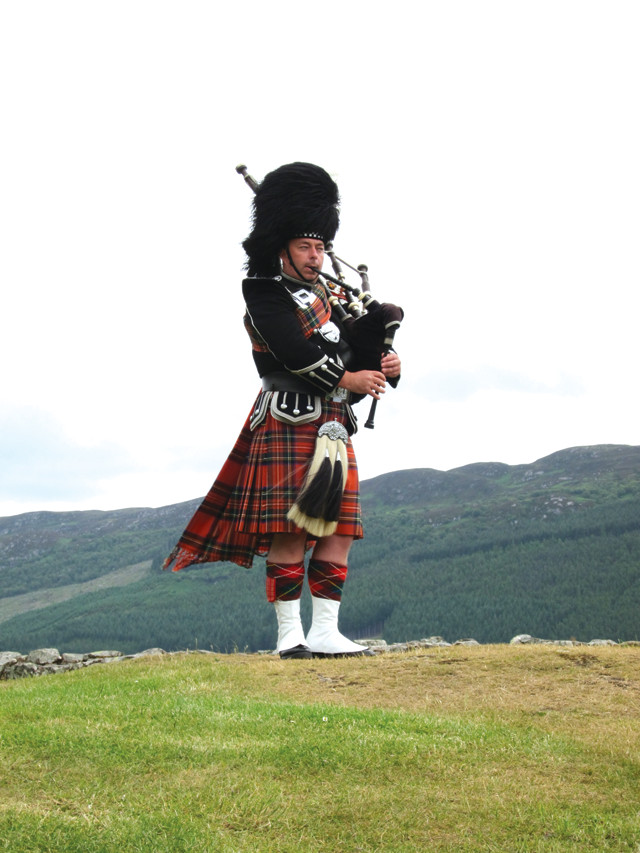
by Ward Chesworth Friday, December 21, 2018

"Pibroch" signifies a Scottish piper's variations on a musical theme. Credit: Alberto Garcia, CC BY-SA 2.0.
“The Gaelic word “pibroch” isn’t one you come across every day. It signifies a Scottish piper’s variations on a musical theme. Although the theme may often be warlike, many pibrochs are laments for the “tears of things,” the lacrimae rerum, or tragedy of existence, of which the old Romans wrote. In 1966, Dionne Warwick turned the popular song “Alfie” — which was composed for the movie of the same name and opened with the iconic line “What’s it all about, Alfie?” — into a poignant lament for human existence that always reminds me of a pibroch.
Let’s forget Alfie for now and ask Earth the same question. In fact, English poet Ted Hughes did just that in his poem entitled — wouldn’t you know it — “Pibroch,” although, being an artist, the question in his mind was probably phrased as, “What’s it all about, Gaia?” However, before I look at Hughes’ offering, I’ll go back a few decades to see what “The Great Explainer,” prolific American writer and biochemist Isaac Asimov, had to say.
Here’s Asimov’s recipe for a planet like Earth: “Weigh out roughly two septillion kilograms of iron, adding 10 percent of nickel as stiffening. Mix well with four septillion kilograms of magnesium silicate, adding 5 percent of sulfur … and small quantities of other elements. Heat in a radioactive furnace and two mutually insoluble layers separate. Cool slowly till the crust hardens and a thin film of adhering gas and moisture appears. Place in an orbit at a comfortable distance from a star and set to spinning. Then wait. In several billion years it will ferment at the surface. The fermented portion [is] called life.” In modern parlance, we might call the planet’s fermented layer the biosphere.
Asimov’s narrative, based on the chemistry of smelting iron ore in a blast furnace, is clever but lacks a few events a geologist would likely include, such as an initial stage of cold accretion before gravitational compression and heat from radioactive elements caused melting, later brought to a climax in the “iron catastrophe” as dense iron, sweated out from Earth’s silicate bulk, accumulated to form the core. Plate tectonics shuffling continents around and Jupiter deflecting asteroid-sized space missiles are also both missing, but hey, Asimov’s recipe is close enough.
So, what did Hughes make of Earth? “Pibroch” is composed of five stanzas that present us with a picture of the biosphere in terms of five elements: sea, land, air, life and time. First, we hear of the sea crying “with its meaningless voice” after “so many millions of nights without sleep, without purpose,” then of the land (or stone) “created for black sleep” and “dreaming it is the foetus of God.” Next comes air as it rushes over the “blind stone,” a wind “able to mingle with nothing.” Then life arrives, “drinking the sea and eating the rock,” and finally time simply accumulates, “minute after minute … nothing lets up or develops.” Darwin would certainly have disputed that last point.
In sum, Hughes’ view sounds like Nietzsche’s nihilism times 10, and by extending it, in the final line, to a place where “the stars bow down,” he manages to embrace the whole universe in his bleak picture. It could be argued that it’s an appropriate vision for these postmodern times, but “Pibroch” is absolutely the wrong title. Pibrochs are about human sorrow, not about lamenting “a lack of purpose in an existential universe,” as critic Terry Gifford says of the poem.
As an antidote, consider “The Lost Pibroch” by Scottish author and journalist Neil Munro. He says that all great pipers must go through an apprenticeship of “seven years of his own learning and seven generations before.” In Munro’s story, Gilian the Piper plays a lament for the Massacre of Glencoe, where Campbells loyal to William III — he of the William and Mary partnership that replaced James II on the British throne — killed MacDonalds who remained faithful to the deposed Stuart sovereign. Gilian conjures up the 1692 scene in graphic detail, the music revealing a Highland pass, where the gray day crawled over a winter’s landscape. Snow choked the pass and smothered the still smoldering lintels and joists of destroyed dwellings, and “the blood of old and young lappered on the hearthstone, and the bairn, with a knifed throat, had an icy lip on a frozen teat.” The tramped snow showed the path that the Campbell butchers took — “far on their way to Glenlyon and the towns of paper and ink and liars.”
Gilian’s pipes throbbed with human tears — “muinntir a’ ghlinne so, muinntir a’ ghlinne so! — oh the people, the people of this glen, this glen!” That’s the sound of a pibroch, not Hughes’ barbaric yawp into the void.
You can lament humanity, for sure, but there is no need to lament Earth itself.
© 2008-2021. All rights reserved. Any copying, redistribution or retransmission of any of the contents of this service without the expressed written permission of the American Geosciences Institute is expressly prohibited. Click here for all copyright requests.